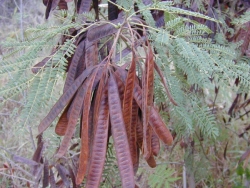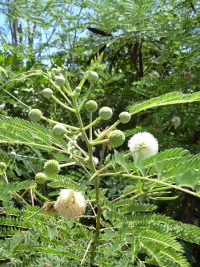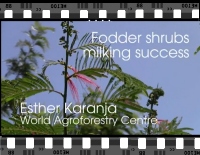 |
Contact usUnited CaribbeanHelp for HaitiHaiti Child CareEmpowerment Programs
Ecological ReforestationGospel Tourism |
home >> haiti>>a
shift program
Haiti reforestation - Leucaena leucocephala Fodder:
In addition, it is very persistent over several decades of cutting or grazing, is highly productive, recovers quickly from defoliation, combines well with companion grasses and can be grazed with minimal losses from trampling or grazing. Forage, packed in pellets and cubes, is internationally marketed as animal feed. Apiculture: L. leucocephala is in bloom almost throughout the year, providing constant forage to honey bees. Fuel: L. leucocephala is an excellent firewood species with a specific gravity of 0.45-0.55 and a high calorific value of 4600 cal/kg. Wood burns steadily with little smoke, few sparks and produces less than 1% ash. The tree makes excellent charcoal with a heating value of 29 mJ/kg and good recovery values (25-30%). Timber: L. leucocephala has hard heavy wood (about 800 kg/m), with a pale yellow sapwood and light reddish-brown heartwood. The wood is known to be of medium density and to dry without splitting or checking. It is strong, medium textured, close grained and easily workable for a wide variety of carpentry purposes.
|
 |
Services Erosion control: An aggressive taproot system helps break up compacted subsoil layers, improving the penetration of moisture into the soil and decreasing surface runoff. Shade or shelter: L. leucocephala is used as a shade tree for cocoa, coffee and tea; it generally acts as a shelterbelt, providing shade and wind protection for a variety of crops, especially during early growth. Reclamation: L. leucocephala thrives on steep slopes and in marginal areas with extended dry seasons, making it a prime candidate for restoring forest cover, watersheds and grasslands. Nitrogen fixing: It has high nitrogen-fixing potential (100-300 kg N/ha a year), related to its abundant root nodulation. Soil improver: L. leucocephala was one of the 1st species to be used for the production of green manure in alley-cropping systems. Leaves of L. leucocephala, even with moderate yields, contain more than enough nitrogen to sustain a maize crop. The finely divided leaves decompose quickly, providing a rapid, short-term influx of nutrients. It has even been suggested that the leaves decompose too rapidly, resulting in leaching of nutrients away from the crop-rooting zone before they are taken up by the crop. This also means that they have little value as mulch for weed control. The tree has the potential to renew soil fertility and could be particularly important in slash-and-burn cultivation, as it greatly reduces the fallow period between crops. A recent report from the U.N. Food and Agriculture Organization shows the pace of deforestation worldwide slowed in the last decade. Clearing land for farming remains the leading cause of deforestation. But in Haiti, the loss of tree cover -- and the erosion that results -- have made it much harder for farmers to grow food. It's a major contributor to the country's hunger problems. Click on the video link below to see the efforts that are underway to try to return trees to Haiti's denuded hills.
Ornamental: Suitable as an ornamental and roadside landscaping species. Boundary or barrier or support: Used as a live fence, firebreak and live support for vines such as pepper, coffee and cocoa, vanilla, yam and passion fruit. Intercropping: Leucaena is one of the most widely used species in alley cropping, where it is planted in hedges along contours at intervals of 3-10 m with crops in between. Other services: The dried seeds are widely used for ornamentation. Animal fodder:
Cows fed Leucaena leucocephala eat less concentrate and do not need to be fed on heavy fertilized grasses. They also have higher live weight gain. However, the leaves should not be fed to breeding animals, however, as they may affect reproduction, stillborn calves are numerous, calving percentage is poor (66% vs. 88%), and calf weight at birth is lower.
Lambs fed leucaena leaf meal have higher survival rate and growth
rate. In spite of mimosine content, reproductive performance is
not altered by dry or fresh leuceana forage in rams. Ewes fed leucaena
hay had good body weight at mating time with higher ovulation rates.
Leucaena may reduce the cost of parasitic control . Pigs: It is possible to feed pigs with low levels of Leucaena leucocephala: 5 to 10 % leucaena leaf meal are recommended in growing and finishing pigs.
Rabbits: Fresh or dried Leucaena leucocephala or leaf meal improves feed intake, feed efficiency and animal performance in rabbits. The recommended inclusion rate ranges from 24% to 40% for growing or fattening rabbits fed on fresh Leucaena leucocephala leaves can replace alfalfa. Leucaena leaf meal may be included at 25% when supplementing a diet based on cassava peels and at 30-40% when rabbits are fed with Arachis pintoi. Leucaena leucocephala is more palatable than Arachis pintoi. Not all rabbit trials with leucaena have been positive. The inclusion of fresh leucaena leaves at 20-25% had deleterious effects on the mortality of female and young rabbits (up to 55% mortality) Fish: It is possible to feed catfish with leucaena leaf meal as a protein source 30% inclusion is suitable for catfish. Leucaena seed meal is a good alternative to soybean meal for catfish fingerlings diets at 20% inclusion level. |
| Copyright © 2022 www.UnitedCaribbean.com. All rights reserved. Disclaimer Click to Contact us |








